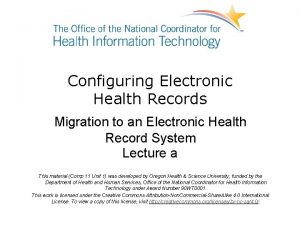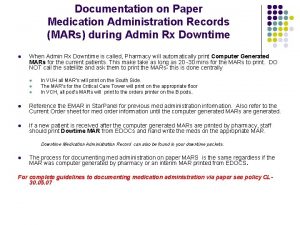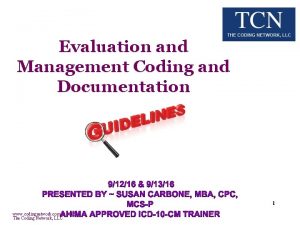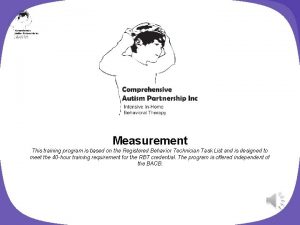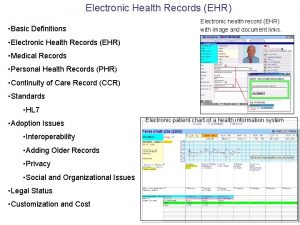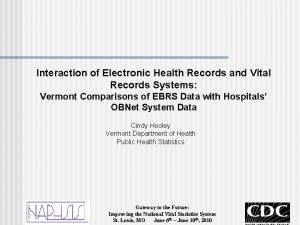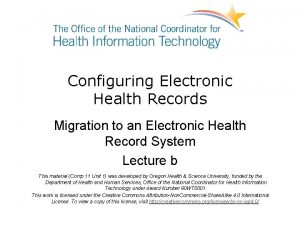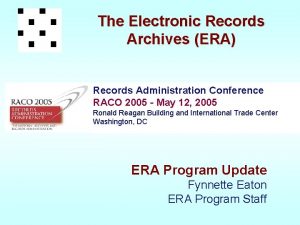Electronic Health Records How to Implement Your Electronic


































- Slides: 34

Electronic Health Records: How to Implement Your Electronic Health Record and Share It Without Getting a HIPAA Headache Tenth National HIPAA Summit April 7, 2005 Sarah E. Coyne 608 -283 -2435 sec@quarles. com 1 South Pinckney Street, Suite 600 Madison, WI 53703

What Is An Electronic Health Record • Real time health record with evidence-based decision support tools to aid clinicians in decision making. • Can support collection of non-clinical data such as billing, quality assurance, etc. • Interoperable = many participants, all sharing records (clinic/hospital = mini-model). • Some of the participants will be covered entities under HIPAA, some will not.

Two Levels of Difficulty • Today’s Difficulty: Internal EHR or 2 participant. • Tomorrow’s Difficulty: Interoperable EHR between multiple entities.

The Interoperable EHR Buzz • On April 27, 2004, President Bush called for widespread adoption of interoperable EHR within ten years. • May 6, 2004, Then DHHS Secretary Tommy Thompson appointed David J. Brailer, M. D. , Ph. D. to serve in this new position. David Brailer • Executive Order 13335 requires the National Health Information Technology Coordinator (NCHIT) to report (within 90 days of operation) on the development and implementation of a strategic plan to guide nationwide implementation of NCHIT in the public and private sectors. • EO 13335 specifically requires National Coordinator to ensure that patients’ IIHI is secure and protected.

DHHS Specified Goals • Inform clinical practice. • Interconnect clinicians. • Personalize care. • Improve population health.

Regional Health Information Organization • Hot term of the day: RHIO. • An organization facilitating electronic health records within a region, state or other designated area. • An actual organized entity with a board and governing bylaws. • Charged with overseeing and implementing a secure health information exchange among the participating providers within that region. • Unclear at this point which organizations will be RHIOs.

National Health Information Infrastructure • National EHR Interoperability – ideally, RHIOs exchanging information with each other. • A workable authentication process for that giant web. • A workable access process. • Security safeguards.

I Lied • There are going to be headaches from HIPAA with interoperable EHRs. • Let’s try to figure out the best medicine to treat those headaches.

Some Headaches • Patient authorization. • Disclosures permitted without authorization (TPO, etc. ). • Patient rights. – Notice of privacy practices. – Requesting amendments. – Restricting modes of communication. – Accounting. – Access to designated record set. – Requested restrictions on disclosures. • Business associate requirements.

More Headaches • Security Rule Authentication is a 3 aspirin headache. • Security Rule Joint Risk Analysis. • Security Rule Implementation Specifications – Especially Those Pesky Addressable Ones! • Minimum Necessary Requirements.

HIPAA Headache #1: State Law Issues/ Preemption • State laws add layer of complexity to every single headache. • Headaches intensify with “special” records where state protections are often more stringent than HIPAA (HIV/AIDS, mental health, AODA, STDs, child abuse).

HIPAA Headache #2: The Minimum Necessary Standard • Each CE in the RHIO may use or disclose only the minimum necessary amount of PHI. • Helpful points: – Exception for Treatment. – May rely on requests as minimum necessary from other CEs. • Same old problem: if you get into the EHR and see a bunch of unrelated stuff, is that a violation of the MNS or is it incidental?

HIPAA Headache #3: Business Associate Requirements • If participating entities perform functions or provide services involving exchange of PHI, RHIO can be structured to include BA provisions. • If the RHIO is an OHCA, providers within the OHCA do not need BAAs. • RHIO itself is likely a BA.

HIPAA Headache #4: What Is A Disclosure? • Internal EHR – the question is going to be appropriate use, not disclosure (e. g. HIV test results). • Interoperable EHR – is every piece of e. PHI in the RHIO disclosed with each cross-entity access? – Need RHIO-wide agreement on this point. – Consider levels of access (greatest access for treatment, HCO etc. ).

HIPAA Headache #5: Patient Authorization • The patchwork of state laws vary as to which disclosures are permitted without patient authorization – greater preemption would help! • Work with IT folks for electronic tracking of patient authorization for each participating provider in the interoperable system. • Consider whether viewing of extraneous e. PHI can legitimately be categorized as incidental disclosures. • To keep claims down, education (of patients AND workforce) is key. • Another key: electronic functionality to achieve tracking of patient authorization.

HIPAA Headache #6: TPO and Other Permitted Disclosures • Where do the RHIO’s activities fit in? – Healthcare operations: QA, business management, general administrative activities. – TPO exception provides broad latitude to move e. PHI within the interoperable record. • Legitimate use for treatment but what about all the incidental disclosures (and internally, uses).

HIPAA Headache #6: TPO and Other Permitted Disclosures • The OHCA concept may help. – Clinically integrated care setting in which individuals typically receive health care from more than one health care provider (but is that always true? ) – Organized system of health care in which more than one CE participates and in which participants hold themselves out to the public as a joint arrangement doing utilization review, QA, or payment activities with risk sharing.

HIPAA Headache #7: Notice Of Privacy Practices • If RHIO = OHCA, Joint NPP permissible. (How’s that for alphabet soup!) • Even then, need uniformity of uses and disclosures within the RHIO.

HIPAA Headache #8: Patient Right to Alternative Modes of Communication • Need RHIO-wide electronic system for patient designation of preferred communication of PHI.

HIPAA Headache #9: Patient Access • Patient has right of access to PHI in a designated record set (DRS) (and non-duplicative PHI held by BAs). • Need RHIO-wide patient access system and this implicates the Security Rule authentication and audit trail headaches. – How will access to RHIO be managed? – Who gets to be the gatekeeper? – What is the DRS for that patient, in the context of the interoperable EHR?

HIPAA Headache #10: Patient Restrictions on Disclosures • Patients may request restrictions on disclosure of their PHI • CE is not obligated to agree, but there is a documentation process for reviewing and responding. • Need centralized RHIO manager for this process.

HIPAA Headache #11: Accounting for Disclosures • Accounting is already an administrative headache. • Interoperable EHR could serve as exponential headache multiplier. • Need automated electronic system for managing RHIO-wide accounting.

HIPAA Headache #12: Requests to Amend • Patient has the right to request amendment of PHI in the DRS. • CE not obligated to acquiesce but process for evaluating and denying. • Need RHIO-wide system for managing such requests and ensuring that if request is granted, PHI is amended on a RHIO-wide basis.

HIPAA Headache #13: Research • RHIO-wide privacy board? • RHIO-wide waivers of authorization? • One simplifying factor: QA studies are HCO, not research.

HIPAA Headache #14: Security Rule Risk Assessment • How do the participating entities measure their risk of participating in a RHIO? • One solution: uniform minimum security practices for all RHIO participants and thus uniform risk analysis.

HIPAA Headache #15: Addressable Implementation Specifications • Each RHIO participant must decide whether each addressable implementation specification is reasonable and appropriate for the RHIO, the shared EHR. • If not, each participant must evaluate the options and document a common solution. • How will each of these work in an interoperable setting? – authorization/supervision of those who work with e. PHI. – method for clearing given members of workforce to specified levels of e. PHI access. – termination of access to e. PHI when workforce members leave.

HIPAA Headache #15: Addressable Implementation Specifications – periodic security updates to workforce of all RHIO CEs. – virus protection. – monitoring log-ins. – password management. – periodic testing and revision of contingency plans. – automatic log-off after periods of inactivity. – encryption/decryption. – mechanism to authenticate e. PHI. – integrity controls.

HIPAA Headache #16: Required Implementation Specifications • Risk analysis – separate analysis for the RHIO? • Reasonable and appropriate risk management – need specified manager for RHIO. • Sanction policy (perhaps best managed on an entity-byentity basis? ) • Information system activity review. • Reporting of security incidents (takes on larger proportions with the interoperable EHR). • Contingency planning for data back up, disaster recovery, emergency mode operation. • Final disposal of e. PHI.

HIPAA Headache #16: Required Implementation Specifications • Removal of e. PHI from media that will be re-used (disks etc. ). • Unique user ID! • Access to e. PHI during emergency. • Person/entity identification. • Policies/procedures/documentation (on a RHIO-wide basis: should each covered entity have a policy specifically addressing participation in the RHIO? ) • 6 year retention – managed on an entity-by-entity basis? What about information stored solely in electronic form? • Don’t lose sight of requirement to update – centralized function in RHIO should coordinate.

HIPAA Headache # 17: Privacy and Security Officers • Security officer. – Required for each covered entity. – Should there be a centralized position for the RHIO? – Additional points addressing the interoperable EHR in the entity SO description? • Same analysis for Privacy officer.

The Best Medicine • Sounds trite, but every participant in the RHIO should be strategically on the same page. • Some sort of uniform patient identification system. • Don’t forget about state law! Some RHIOs will cross state lines. • If possible, start with an existing structure/ organization. • Have a lot of money. • Another one that sounds trite: trust.

The Best Medicine • Leader to initiate and oversee. • Commitment: If you’re in, you’re in. • Some system of measurement: How is it working? • Joint accountability for success. • Everything on the table: No hidden agenda. • Neutral meeting ground for organizational efforts.

The Best Medicine • Interface with: – State officials (include the Governor!) – Local academic medical centers – Local hospitals – Local health plans – Local employers – Local professional societies and associations – Consultants and vendors (don’t forget the lawyers!) – QIOs

Electronic Health Records: How to Implement Your Electronic Health Record and Share It Without Getting a HIPAA Headache Tenth National HIPAA Summit April 7, 2005 Sarah E. Coyne 608 -283 -2435 sec@quarles. com 1 South Pinckney Street, Suite 600 Madison, WI 53703
 System development life cycle of electronic health records
System development life cycle of electronic health records Electronic medical records pros and cons
Electronic medical records pros and cons Electronic health records
Electronic health records Natural language generation for electronic health records
Natural language generation for electronic health records +electronic +health +records +migration
+electronic +health +records +migration Your startup wants to implement an order fulfillment
Your startup wants to implement an order fulfillment Paper medication administration record
Paper medication administration record Paper vs electronic medical records
Paper vs electronic medical records Uncitral model law on electronic signatures
Uncitral model law on electronic signatures Benefits of public health
Benefits of public health Electronic medical records
Electronic medical records Reiser implement
Reiser implement Discontinuous measurement procedures
Discontinuous measurement procedures Trimble true guide
Trimble true guide Acquiring capital to implement strategies
Acquiring capital to implement strategies Implementing strategies: management and operations issues
Implementing strategies: management and operations issues Implement profiel banden
Implement profiel banden Eschew the implement of correction and vitiate the scion
Eschew the implement of correction and vitiate the scion Implement tasks that promote reasoning and problem solving
Implement tasks that promote reasoning and problem solving Implement food safety procedures
Implement food safety procedures Implement food safety procedures
Implement food safety procedures Develop vs implement
Develop vs implement Storage area network diagram
Storage area network diagram Polynomial manipulation in linked list in data structure
Polynomial manipulation in linked list in data structure Why are user interfaces hard to implement
Why are user interfaces hard to implement Implement change management with these six steps
Implement change management with these six steps 3 stage pipeline arm organization
3 stage pipeline arm organization Swing components
Swing components Toilet preparation act 1955
Toilet preparation act 1955 Implement imi
Implement imi Develop and implement a food safety program
Develop and implement a food safety program Implement
Implement Your health is your responsibility
Your health is your responsibility Give us your hungry your tired your poor
Give us your hungry your tired your poor An electronic is the electronic exchange of money or scrip
An electronic is the electronic exchange of money or scrip




